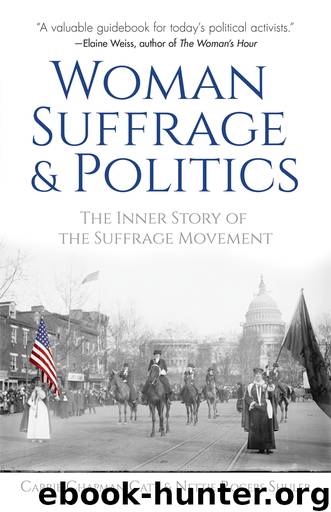Woman Suffrage and Politics by Carrie Chapman Catt

Author:Carrie Chapman Catt
Language: eng
Format: epub
Publisher: Dover Publications
Published: 2020-07-18T16:00:00+00:00
CHAPTER 18
The Fighting Forces
In the struggle from which the final woman suffrage victory was now about to emerge four groups of fighting forces were engaged. They were the Suffragists, the Liquor Interests, the Anti-Suffragists and the Prohibitionists.
In the suffrage army there were over two million women enlisted. The parent body, the National American Woman Suffrage Association, directed the activities of the great mass of them, while the Woman’s Party projected its entirely separate and often conflicting program for the group of militants. When victory finally perched upon the banners of the suffragists the National Suffrage Association had direct auxiliaries in forty-six States of the Union and these far-reaching confederated bodies were functioning as one organ through its centralized national board. Extensive headquarters were maintained in both Washington and New York. In Washington congressional activities radiated from the great house at 1626 Rhode Island Avenue. In New York headquarters occupied two entire floors, equivalent to thirty large rooms, of a business building on Madison Avenue. Between forty and fifty women were continuously retained on the clerical staff, and as many field workers were engaged in campaigns. A publishing company prepared and printed literature of various kinds. Publicity, organization, data and educational departments constituted branches of the general administration, and a weekly thirty-two-page magazine, the Woman Citizen, was maintained as the Association’s official organ and mouthpiece.
Historically, the National American Woman Suffrage Association presents a record of intensive organization probably never paralleled. Through half a century of incessant work that record reaches back to 1869. Even fifteen years before that time suffrage work of an agitational kind had been conducted by local committees or clubs under the direction of a strongly centralized national board. That plan of organization served the purposes of the early time admirably, but when it became clear that the women must for a time go to the States to seek and win their suffrage by referenda campaigns, a different form of organization was found necessary. The workers, therefore, by common consent in 1869, prepared the way for a new body better adapted to the new phase of the struggle. Out of the process, two organizations emerged—The National Woman Suffrage Association and The American Woman Suffrage Association, the first led by Elizabeth Cady Stanton and Susan B. Anthony, the second by Lucy Stone, the differences being more personal than tactical.
The aims of both were the same, to secure suffrage for women whenever possible and by any constitutional method. The National emphasized the federal suffrage method by holding annual conventions in Washington and securing hearings on the Federal Suffrage Amendment, but it maintained, too, the policy of winning woman suffrage State by State until enough States should have adopted it to make women voters an element no longer negligible in the constituencies of United States Congressmen who would someday vote on the Federal Suffrage Amendment. The “American” concentrated on State campaigns with the same end in view, whenever federal action should be possible. The field was wide and by tacit consent the two organizations kept out of each other’s way, only a few States having auxiliaries to both.
Download
This site does not store any files on its server. We only index and link to content provided by other sites. Please contact the content providers to delete copyright contents if any and email us, we'll remove relevant links or contents immediately.
The Secret History by Donna Tartt(18837)
The Social Justice Warrior Handbook by Lisa De Pasquale(12141)
Thirteen Reasons Why by Jay Asher(8789)
This Is How You Lose Her by Junot Diaz(6777)
Weapons of Math Destruction by Cathy O'Neil(6138)
Zero to One by Peter Thiel(5684)
Beartown by Fredrik Backman(5594)
The Myth of the Strong Leader by Archie Brown(5420)
The Fire Next Time by James Baldwin(5246)
How Democracies Die by Steven Levitsky & Daniel Ziblatt(5127)
Promise Me, Dad by Joe Biden(5087)
Stone's Rules by Roger Stone(5025)
100 Deadly Skills by Clint Emerson(4840)
A Higher Loyalty: Truth, Lies, and Leadership by James Comey(4839)
Rise and Kill First by Ronen Bergman(4701)
Secrecy World by Jake Bernstein(4639)
The David Icke Guide to the Global Conspiracy (and how to end it) by David Icke(4624)
The Farm by Tom Rob Smith(4434)
The Doomsday Machine by Daniel Ellsberg(4415)
